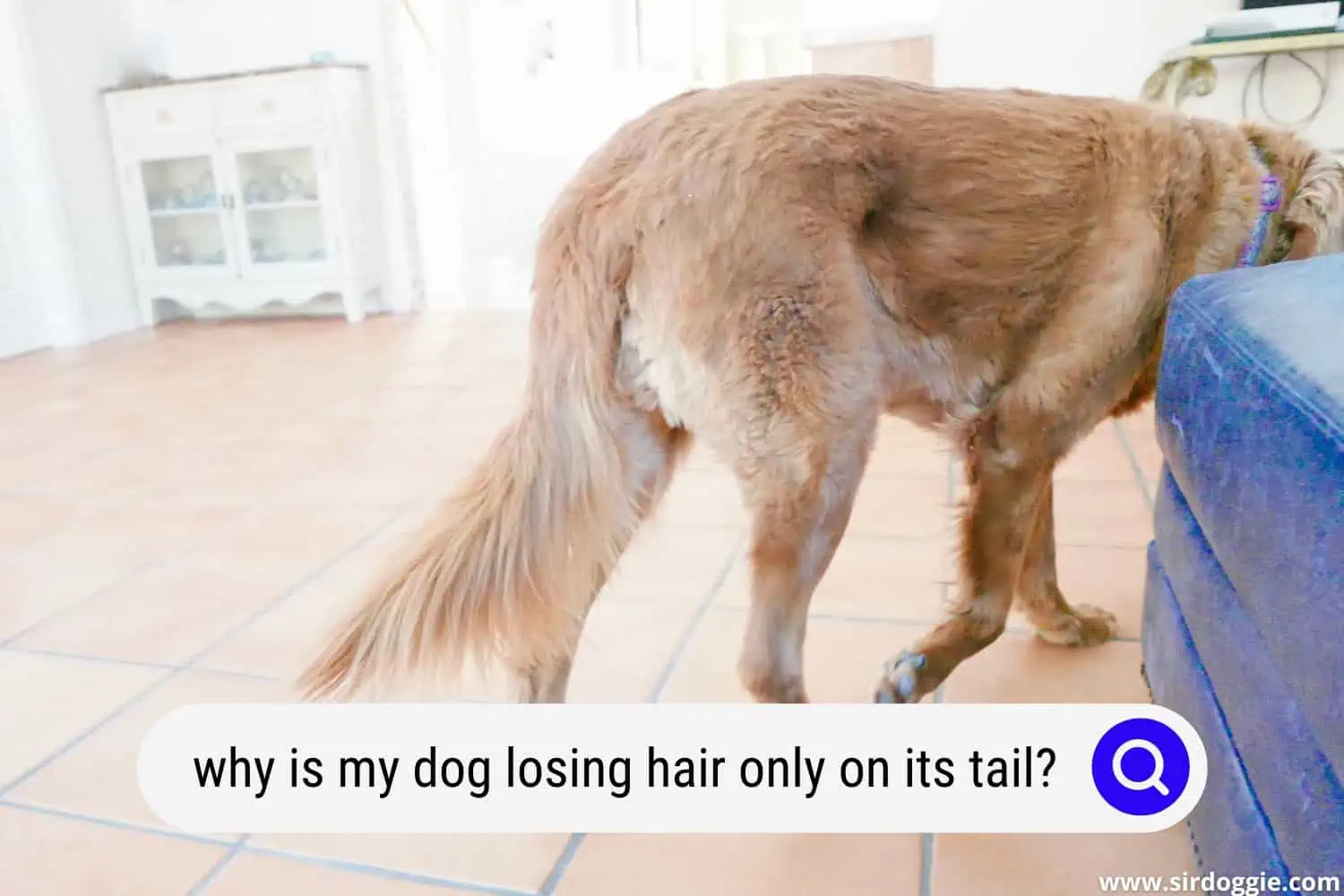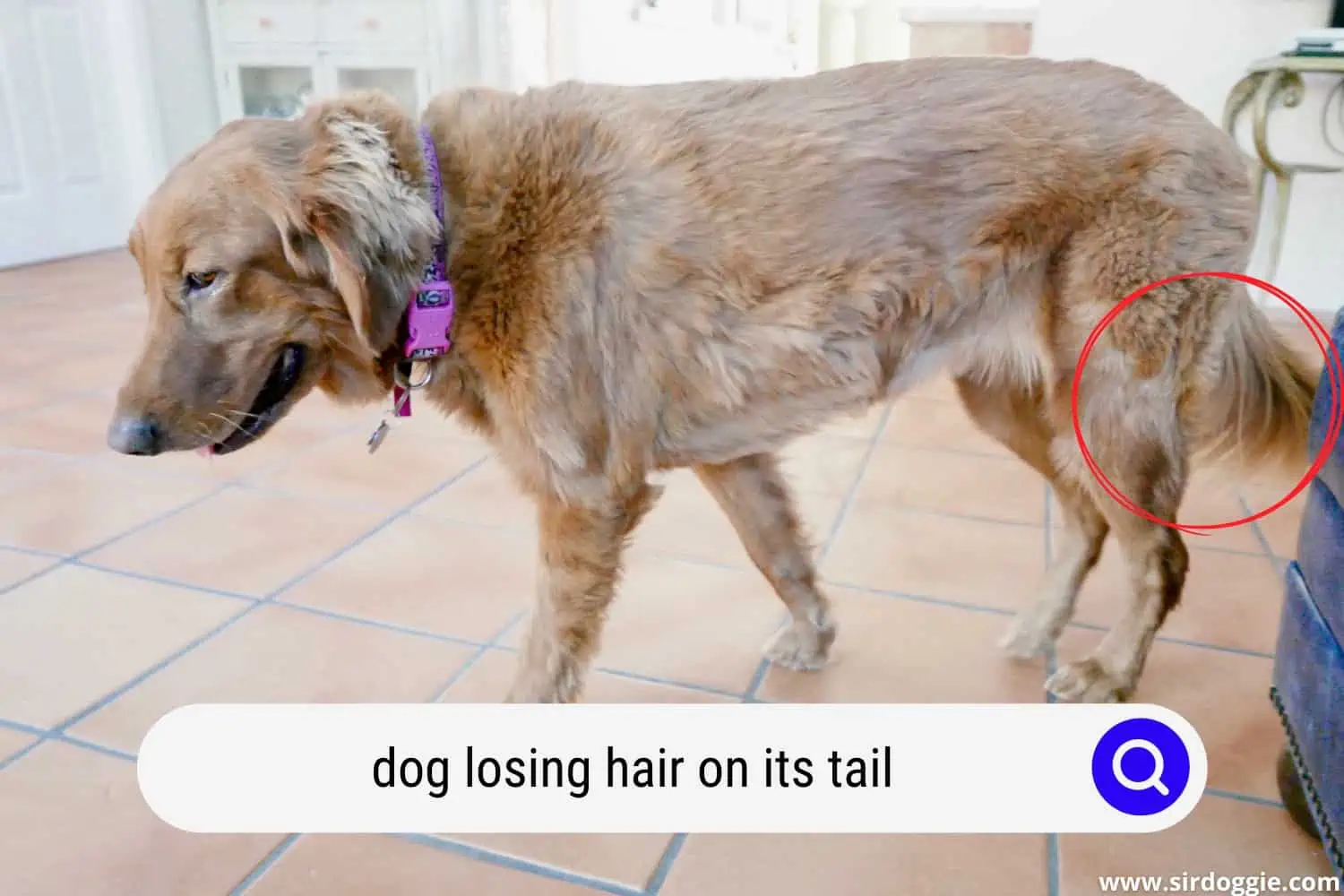Why Is My Dog Losing Hair Only On Its Tail?
At some point, you may notice that your dog is losing its hair.
Whilst it is normal for dogs to shed hair from all over their body, especially during shedding season, when you see that they are losing hair in patches from one specific part of their body, and this is causing them discomfort, then you know there is a problem.
In this article, we will look at some of the reasons why your dog is losing hair only on its tail, back legs, around the eyes, or on the elbows – all commonplaces of hair loss in dogs.

What Is Alopecia?
The scientific name for hair loss (in dogs and humans) is alopecia. Alopecia can present itself as gradual hair loss, or sudden hair loss. This hair loss may be symmetrical, or it may appear as bald patches. Alopecia can affect any part of the dog’s body, and may or may not be accompanied by skin irritation – redness, itchiness, scabbing, and oozing pus.
Sometimes alopecia is caused by certain medical conditions, which we will address later in this article.
But before we do, it needs to be pointed out that alopecia is associated with certain purebred dog breeds. For example, whippets, greyhounds, and dachshunds all seem prone to losing hair in patches.
Purebred Dog Breeds Prone to Hair Loss
Whippets, greyhounds, and dachshunds all have one thing in common – a fine, short coat.
When I first got my whippet, I was concerned that he appeared to have areas on his body where the hair was almost non-existent. They are mainly on his underside, near his hind legs. These cover quite a large area and are quite even.
I joined an online whippet forum and discovered that this is quite common, and just one of those things that we have to accept.
My whippet does not scratch or lick at his baldish areas, and the vet has never commented on them during our yearly vet check-ups. The skin on the baldish patches is healthy, pink, and scab-free. So this type of alopecia is little cause for concern.
I just make sure that my whippet is nice and warm, and accept that it is what it is.
However, if you can rule out that this is not the case with your dog, then there are other reasons why your dog may be losing hair on its tail, on its back legs, around its eyes, and on its elbows.
Medical Reasons For Hair Loss In Dogs
Please be advised that only a qualified veterinarian can diagnose any of these conditions. They may do so via a physical exam, taking scrapings from the skin (which is painless), and conducting blood tests.
Once your veterinarian knows what is causing your dog’s alopecia, then they can start your dog on the proper course of treatment.
Related Reading: Dog Breeds With Tails That Curl Up Are Plentiful In Showdogs
Ringworm
Ringworm is a highly contagious fungal infection that presents as red, raised circles on the dog’s skin. Despite the name, ringworm is not a worm at all. Treatment for ringworm is a topical ointment to kill the fungus, plus an oral anti-fungal tablet.
Allergies
Like us, dogs can have allergies too. And one of the symptoms of an allergy can be hair loss.
Dogs may be allergic to something in their food, in which case your vet can recommend some diet changes to help your dog recover their health (and their hair.)
Dogs can also be allergic to something in the environment, such as pollen, mold spores, and fleas (there is a protein in the flea’s saliva that can trigger an allergic skin reaction in dogs.) Fleas are easily eradicated using a good brand of flea treatment, and other allergens in the environment can be reduced with some lifestyle changes.
Bacterial Infections
A bacterial skin infection in dogs can present as ‘hot spots’ – areas on the dog’s skin where the hair falls out, and the skin is red and oozing. The dog can’t stop licking them. I used to have a Labrador and he suffered from hot spots quite badly. They are awful! The bacteria that causes hot spots love moist areas, so if your dog is a swimmer, then make sure they dry off properly.
I used to make an at-home remedy to soothe the itch if we were waiting to see the vet – which was to make a paste out of water and oatmeal. Putting a cone or Elizabethan collar on your dog may help stop them from licking a hot spot, which makes them worse.
Mites and Mange
There are a few different types of parasites that cause mange. One is transmissible to humans; it is called ‘Sarcoptic mange’. Mites cause the dog’s skin to itch because they bury into their skin and lay eggs, therefore the poor dog will continually scratch to get relief, resulting in bald patches.
There are a few different ways your vet can treat mites, including tablets, baths, and injections.
Wear and Tear
Dogs that lose hair on their elbows may simply be experiencing the hair rubbing away over time from when the dog is lying down, particularly if on an abrasive surface such as concrete.
Try to encourage your hound to lie on a raised dog bed if this sounds like your situation. Having said that, my cattle dog just loves to lie on cement, despite having a dog bed and an armchair at her disposal. She likes the coolness of it.

To Conclude
Some of these medical conditions cause a dog to lose hair from a specific part of the body. For example, hair loss around the tail may indicate fleas, while hair loss around the eyes may be due to ringworm. Hair loss on a dog’s elbows may simply be due to the friction caused by a hard surface your dog lies on rubbing the hair away over time.
As with anything abnormal when it comes to your four-legged best friend, don’t wait – take them to the vet for a proper and accurate diagnosis.
Related Reading: Why Do Dogs Cuddle With You?

Family Dog Expert Author
Hi there! I’m Stuart, a devoted dog lover and family dog expert with over a decade of experience working with our furry companions. My passion for dogs drives me to share my knowledge and expertise, helping families build strong, loving bonds with their four-legged friends. When I’m not writing for SirDoggie, you’ll find me hiking, playing with my beautiful dog, or studying music.